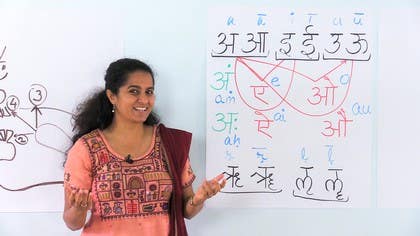Description
About This Video
Transcript
Read Full Transcript
Namaste and welcome once again into this journey to discover the wonder that is Sanskrit. Today we are going to look at the Sanskrit alphabets. In Sanskrit the word for alphabet is varana mala, mala meaning a garland and varana meaning colors. In a sense this journey into the alphabet is also a journey into the different sounds that compose these letters. Sounds can also be understood as colors at another level. So what we are going to discover today are the different shades that form this beautiful garland of sounds. The beauty of the Sanskrit alphabet or the varana mala is that it follows a very systematic arrangement of sounds, the way the sound comes out of the human vocal system. So I would like to start by showing you something about where the sounds are placed within the vocal system. That is my version of the human vocal instrument. It has a funny nose there. So the human vocal instrument is divided into five parts. We have the throats, we have the back of the palate, then we have the center of the palate, we have the teeth and we have the lips. So that is the first which is known as the guttural. The second part of touch is known as the palatals. This often also happens when the tongue comes below the teeth there. The third is when it touches the roof of the mouth, the center of the roof of the mouth known as the cerebrals. Then we have the tongue touching the back of the teeth, the flat part of the teeth which is the dentals. And then finally we have the lips or the labials. So we have the guttural, the palatals, the cerebrals, the dentals and the labials. All of the letters of the Sanskrit alphabet correspond to these areas of touch and pronunciation. And therefore going through the Sanskrit alphabet is very much like understanding the whole mechanism of sound itself. One of the huge advantages of that is that since one knows what is happening at the level of one's mouth with these sounds, subconsciously it helps to fine tune our hearing and our speech. As a result understanding the sounds and using these sounds using the Sanskrit language is a very very good way of fine tuning the auditory and the oral mechanisms. Personally I have found that knowing where the sound emerges from is very very helpful in learning new languages. I happen to speak a few so I know that when I try to learn a new language people often tell me but how do you get the sound right and I always attribute it to Sanskrit because I think that the very fact of subconsciously having programmed my brain to place the tongue at a point when it hears a particular sound is so ingrained in the system that when I hear a sound the body knows exactly where to place itself or the tongue knows where to place itself to reproduce that sound. So I think that if you have a good mastery over the sounds of the Sanskrit language it can be a very big doorway to receiving sounds of other languages and how good can it get? Thank you.
Mother Tongue: The Sound of Sanskrit
Comments
You need to be a subscriber to post a comment.
Please Log In or Create an Account to start your free trial.












